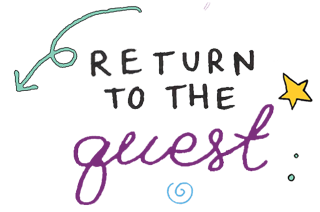
The lost city (Part 1)
| Objective: To plan the mapping of a mysterious lost city! |
Duration: 60 to 90 minutes
Material:
A sheet of paper or cardboard
Pencils and eraser
Instructions:
Prepare the sheet. Your mission will be to map a mysterious lost city! To help you get lots of ideas and organize them, prepare your sheet by drawing a horizontal line to separate it into two equal rectangles. In the top rectangle write "ideas" and in the bottom rectangle write "draft."
Think about your first ideas. To support your conception, follow the next steps, while also letting your imagination run wild, and write down all your ideas in the “ideas” part of your sheet.
- What is a lost city? Using the definition of loss you gave for the Idea stretching activity, start by thinking about what it can mean for a city—or a town or a village—to be lost: Has it completely disappeared from the face of the earth? Is it simply forgotten... or is it maybe hidden? Unless it’s a "lost cause"—that is, a civilization doomed to failure?
- Why is the city lost? Then ask yourself why the city is lost: Did it collapse as a result of a fatal economic crisis, a destructive war, or an ecological disaster? Did its members choose to go into hiding in order to preserve their particular way of life? Was it swept away by great innovations that led to its loss? Or did it fail to adapt to change?
Tip: To help you imagine the lost city, you can use this question to guide your conception: What message could the lost city pass down to humankind? Could it show the dire consequences of exploiting natural resources... or offer an example of an alternative way of life? This can help orient your creative choices so as to convey this message of warning or hope! - Where is the lost city hidden? Now think about the lost city’s location: Is it perched on a mountain, shrouded by clouds, buried under dunes, submerged at the bottom of the ocean, exiled to a distant plain or camouflaged in the jungle?
- Who are the inhabitants of the lost city? Ask yourself about the inhabitants of this mysterious city: What are their values and worldviews? Are these associated with certain beliefs, customs and traditions? How do they spend their days? What are their hobbies or occupations? Do they have particular political and legal organizations? How are decisions made in their community? Who determines the rules and how are they enforced?
- What structures are there in the lost city? Taking into account your answers to the previous questions, imagine the different structures built by the community in the lost city. What kind of environment do they live in? What are their houses like? Do these have any special features? What public spaces are there: schools, hospitals, parks, libraries, markets, etc.? What about their public services, like security, waste management, transport, etc.?
Sketch your ideas. Now that you've got a bunch of great ideas, it's time to see what they look like! In the “draft” area of your sheet, sketch the map of the lost city. It's not your final creation yet, so this drawing doesn't need to be too neat. It's mainly to see if your ideas work and to change them if necessary. You'll find that you'll have lots of new ideas as you start to create!
That's all for now! Don't forget that this activity is only the first part of your creative project! You can start the second part—Creative Construction—right after this one or after you've done the Philosophical Picnic, but we recommend that you at least take a break. You've earned it!
...
Bonus: The location of the lost city might be unknown, but its memory can be preserved through myths and legends! To take your creative thinking even further, you can write the myth or legend of this mysterious city to recount its wonderful achievements and terrible defeats, from its origin to the moment of its loss! Then ask yourself: If something is remembered, is it really lost? Is memory enough to prevent loss? Why or why not? |

| Tricks for tots: If imagining an entire city seems a bit daunting, just think of one person living in the lost city. Ask yourself what this person could teach you about the city in which they live. Imagine their daily activities and interactions with other members of the community. What are their favourite foods and hobbies? What do they wear and where do they get their clothes? What do they do for fun and to support themselves? Did this person play a part in the loss of the city... or did they fight hard to turn things around? |
| Tips for teens: Did you know that a 15 year-old boy from Québec has potentially discovered a lost city? That's right, thanks to his original theory that the Mayans chose the location of their cities based on the constellations, he found a promising site to investigate. No scientist had ever thought of such a link between the position of the stars and the location of Mayan cities! The teenager did not understand why the Mayans had built their cities so far from rivers, on infertile land and in the mountains. According to him, there must have been another reason! Based on his experience, imagine a scientific theory that would allow you to find the lost city you imagined. Then ask yourself the following questions: Do you have to be an expert to make great discoveries? Can young people contribute to scientific research? If so, what could they bring to the scientific community? What does science lose by excluding young people? |
Share your creative reflections by sending them via email.
Include photos of your projects and notes of your thoughts, as well as your first name and your age!


